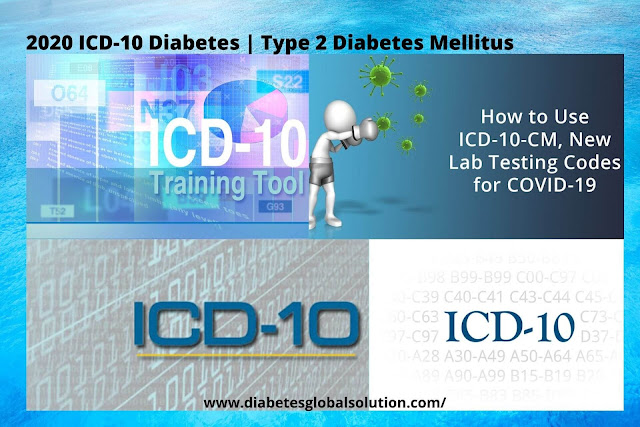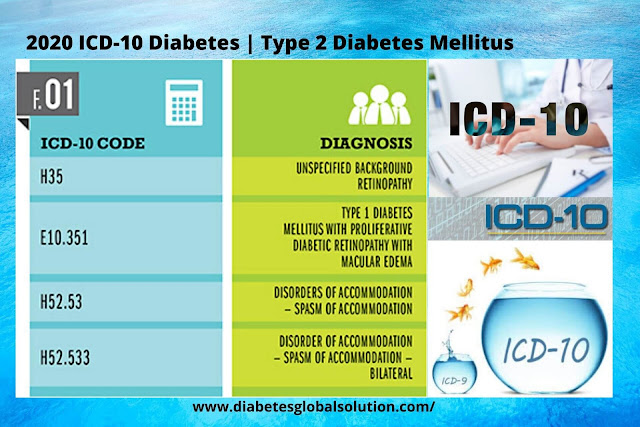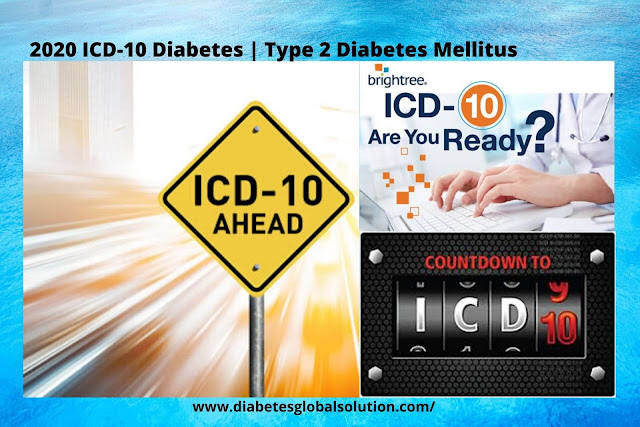The ICD-10-CM Diabetes represents International Classification of
Diseases, Tenth Revision, Clinical Modification. It is a framework utilized by
doctors and other medicinal services suppliers to order and code all analyses,
side effects and methods recorded related to emergency medical care in the
United States.
ICD-10-CM codes are significant on the grounds that they are
more granular than ICD-10 codes and can give more data about the seriousness of
a patient's condition.
The transition to ICD-10-CM Diabetes from ICD-9-CM was additionally
required by the way that the last was coming up short on code ability to grow,
as the vast majority of the code classifications were totally full. Moreover,
ICD-9-CM codes came up short on the particularity and detail gave by ICD-10-CM.
Diabetes refers to an excessive increase in blood glucose or
glucose. A subtype of diabetes mellitus (Type 1 Diabetes) that is described by
insulin insufficiency.
It is showed by the unexpected beginning of extreme
hyperglycemia, quick movement to diabetic ketoacidosis, and passing except if
rewarded with insulin. The infection may happen at any age yet is generally
basic in children or adolescents.
With type 1 diabetes, your pancreas doesn't make insulin.
Insulin is a hormone that assists glucose with getting into your cells to give
them vitality. Without insulin, an excess of glucose remains in your blood.
After some time, high blood glucose can prompt difficult issues with your eyes,
heart, nerves, kidneys, teeth, and gums.
Type 1 diabetes happens regularly in kids and adolescents,
however, can show up at any age.
Type 1 Diabetes includes Juvenile
onset diabetes (Mellitus); idiopathic diabetes (Mellitus); brittle diabetes (Mellitus); ketosis-prone
diabetes (Mellitus); diabetes (Mellitus) due to autoimmune process and diabetes
(Mellitus) due to immune-mediated pancreatic islet beta-cell destruction.
ICD-10 Diabetes Type 1 Codes
E 10
|
Diabetes Mellitus Type 1
|
E 10.1
|
Diabetes Mellitus Type 1 with
ketoacidosis
|
E 10.2
|
Diabetes Mellitus Type 1 with
kidney complications
|
E 10.3
|
Diabetes Mellitus Type 1 with
ophthalmic complications
|
E 10.4
|
Diabetes Mellitus Type 1 with
neurological complications
|
E 10.5
|
Diabetes Mellitus Type 1 with
circulatory complications
|
E 10.6
|
Diabetes Mellitus Type 1 with
other specified complications
|
ICD 10 Diabetes Codes Cheat Sheet
The Centres for Medicare and Medicaid
Services administers the new ICD-10 Cheat Sheet for
doctors. The Centres for Medicare and Medicaid Services is propelling a
progression of new ICD-10 guidance docs for doctor practices of numerous
specialities, filling in as virtual cheat sheets for choosing the suitable
coding.
The guidance, beginning with family practice, strolls through all the
ordinary clinical situations in a wide scope of administrations that a family
doctor regularly observes, and gives the proper code for each type of situation
in each type of classification. The guidance for family practice alone is
thirty-one pages long, giving basic codes for explicit administrations over
twelve types of treatment, and giving the particular codes for explicit
administrations inside every treatment type.
For example, it gives the suitable code for 12 explicit types
of stomach torment. Other treatment classifications with the fitting code given
for explicit types of conditions spread intense respiratory contaminations,
back/neck torment, chest torment, different types of coronary illness, diabetes
mellitus without complexities Type 2, general clinical assessment, cerebral
pain, hypertension, torment in joints, torment in the appendage, and urinary
tract disease/cystitis.
The Centres for Medicare and Medicaid Services in its guidance likewise offers clinical documentation tips covering
hypertension, asthma, underdosing, stomach torment or delicacy, and diabetes
(hyperglycemia & hypoglycemia).
ICD 10 Diabetes with Unspecified Retinopathy
E11.319 is a billable ICD code used to indicate a finding of
type 2 diabetes mellitus with vague diabetic retinopathy without macular edema.
A 'billable code' is point by point enough to be utilized to determine a
clinical conclusion.
Diabetic retinopathy otherwise called diabetic eye malady is
when harm happens to the retina because of diabetes. It can, in the long run,
lead to visual impairment.
ICD 10 Code for Diabetes Mellitus Type 2 Uncontrolled
Uncontrolled and ineffectively controlled are not tradable
while depicting diabetes in ICD-10-CM. Uncontrolled can mean either
hyperglycemia or hypoglycemia and is filed as such in ICD-10-CM. Ineffectively
controlled methods hyperglycemia per the ICD-10-CM file.
E11.65 is a billable code used to determine a clinical
analysis of type 2 diabetes mellitus with uncontrolled diabetes mellitus 2.
The ICD-10-CM code E11.65 may likewise be utilized to
determine conditions or terms like a diabetic - helpless control, diabetic
serious hyperglycemia, haemoglobin - diabetic control discovering, haemoglobin more prominent
than 9% showing helpless diabetic control, hyperglycemia because of type 2
diabetes mellitus, the hyperglycaemic emergency in diabetes mellitus, and so on
Hypertension ICD 10
ICD-10 uses just a solitary code for people who meet models
for hypertension and don't have comorbid heart or kidney ailment. That code is
I10, (essential) hypertension.
It incorporates hypertension; hypertension: blood vessel,
amiable, basic, threatening, essential, foundational.
A pulse of 140/90 or higher. Hypertension, as a rule, has no
indications. It can hurt the corridors and cause an expansion in the danger of
stroke, coronary episode, kidney disappointment, and visual impairment.
A confusion portrayed by an obsessive increment in
circulatory strain; a rehashed height in the pulse surpassing 140 more than 90
mm Hg.
Hypertension happening without previous renal illness or
known natural reason.
Obsessive increment in circulatory strain; a more than once
raised pulse surpassing 140 more than 90 mmHg.
Constantly high blood vessel circulatory strain.
Proper ICD 10 Code for Type 2 Diabetes Mellitus with Multiple
Complications
E11.8 is a billable code used to determine a clinical finding of type 2 diabetes mellitus with unspecified multiple complications.
E11.8 is a billable code used to determine a clinical finding of type 2 diabetes mellitus with unspecified multiple complications.
The ICD-10-CM code E11.8 may likewise be utilized to
determine conditions or terms like the nonappearance of lower appendage because
of diabetes mellitus, an intense intricacy with diabetes mellitus, diabetic
difficulty, diabetic observing - infusion destinations, diabetic checking -
infusion locales irregular, a confusion related with very much controlled type
2 diabetes mellitus, and so forth
ICD 10 Hyperlipidemia
ICD 10 Hyperlipidemia
E78.5 is an explicit
or billable ICD-10-CM code that can be utilized to show a conclusion for
repayment purposes.
Hyperlipidemia is a term used to depict significant levels of
fat in the blood, for example, triglycerides and cholesterol.
Conditions with abundance lipids in the blood. An overabundance
of lipids in the blood.
ICD 10 codes
A00-B99
|
Marked irresistible and parasitic illnesses.
|
C00-D49
|
Neoplasms
|
D50-D89
|
Illnesses of the blood and blood-shaping
organs and certain scatters including the safe instrument
|
E00-E89
|
Metabolic, nutritional and endocrine
diseases
|
F01-F99
|
Neurodevelopmental, mental and behavioral disorders
|
G00-G99
|
Nervous system diseases
|
H00-H59
|
Adnexa and eye diseases
|
H60-H95
|
Ear and mastoid
process diseases
|
I00-I99
|
Circulatory system diseases
|
J00-J99
|
Respiratory system diseases
|
K00-K95
|
Digestive system diseases
|
L00 - L99
|
Subcutaneous tissue and skin diseases
|
M00 - M99
|
Connective tissue and
musculoskeletal
system diseases
|
N00 - N99
|
Genitourinary system diseases
|
O00 - O9A
|
Puerperium, childbirth and the pregnancy
|
P00-P96
|
Specific contingencies beginning in the
perinatal period
|
Q00-Q99
|
Congenital deformations, congenital
malformations, chromosomal abnormalities
|
R00-R99
|
Sign, symptoms and irregular clinical and
research centre discoveries, not somewhere else grouped
|
S00-T88
|
Pain, harming and certain different outcomes
of outer causes
|
U00-U85
|
Special purposes codes include U07-U85
|
V00-Y99
|
Obvious conditions of morbidity
|
Z00-Z99
|
Elements affecting wellbeing status and
contact with wellbeing administrations
|
ICD 10 Codes for Diabetes Mellitus
Diabetes mellitus E08-E13
E08
|
Diabetes mellitus due to
underlying condition
|
E09
|
Drug or chemical induced
diabetes mellitus
|
E10
|
Type 1 diabetes mellitus
|
E11
|
Type 2 diabetes mellitus
|
E13
|
Other specified diabetes
mellitus
|
What information is required to accurately code PVD with
diabetes in ICD-10-cm?
PVD is the contraction of Peripheral Vascular Disease. (PVD) is a circulatory condition bringing about diminished bloodstream to the furthest points, ordinarily happening in the legs. The most widely recognized indication of PVD is discontinuous claudication, which is torment while strolling that settle following a couple of moments of rest. The area of the torment will rely upon the site of the limited or stopped up supply route.
PVD is the contraction of Peripheral Vascular Disease. (PVD) is a circulatory condition bringing about diminished bloodstream to the furthest points, ordinarily happening in the legs. The most widely recognized indication of PVD is discontinuous claudication, which is torment while strolling that settle following a couple of moments of rest. The area of the torment will rely upon the site of the limited or stopped up supply route.
ICD-10-CM files PVD with diabetes with one code. For
legitimate code choice, the supplier must archive if the patient has gangrene
or not. Glance in the ICD-10-CM Alphabetic Index for Diabetes, diabetic with fringe
angiopathy which guides the coder to E11.51
What Is the ICD 10 Code for Type 2 Diabetes
What Is the ICD 10 Code for Type 2 Diabetes
A malady wherein the body doesn't control
the measure of glucose in the blood and the kidneys make an excess of urine. This sickness happens when the body
doesn't make enough insulin or doesn't utilize the manner in which it should. A
heterogeneous gathering of disarranges described by hyperglycemia and glucose
bigotry.
A metabolic issue portrayed by anomalous
high glucose levels because of decreased creation of insulin or insulin
opposition/desensitization.
A subclass of diabetes mellitus (Type 2
Diabetes) that isn't insulin-responsive or subordinate (NIDDM). It is described
at first by insulin opposition and hyperinsulinemia, and in the long run by
glucose prejudice; hyperglycemia; and unmistakable diabetes. Type 2 diabetes
mellitus is not, at this point considered an ailment only found in grown-ups.
Patients only from time to time create ketosis however frequently display
heftiness.
The ICD 10 code for diabetes type 2 is E11. There are numerous codes beneath it that contain a more
noteworthy degree of detail.
ICD 10
code for type 2 diabetes
E 11
|
Type
2 Diabetes Mellitus
|
E
11.0
|
Diabetes mellitus type 2 with hyperosmolarity
|
E
11.1
|
Diabetes
mellitus type 2
with ketoacidosis
|
E
11.2
|
Diabetes
mellitus type 2
with kidney complexities
|
E
11.3
|
Diabetes
mellitus type 2
with ophthalmic complexities
|
E
11.4
|
Diabetes
mellitus type 2 with
neurological complexities
|
E 11.5
|
Diabetes
mellitus type 2
with circulatory complexities
|
E
11.6
|
Diabetes
mellitus type 2 with
other specified complexities
|
COPD ICD 10
COPD stands for Chronic obstructive pulmonary disease, unspecified. J44.9 is a billable-explicit
ICD-10-CM code for COPD that can be utilized to demonstrate a determination for
repayment purposes.
A constant and dynamic lung issue
described by the loss of versatility of the bronchial tree and the air sacs,
pulverization of the air sacs divider, thickening of the bronchial divider, and
mucous collection in the bronchial tree. The pathologic changes bring about the
disturbance of the wind stream in the bronchial aviation routes. Signs and
manifestations incorporate brevity of breath, wheezing, profitable hack, and
chest snugness. The two principal types of the interminable obstructive
pneumonic malady are incessant obstructive bronchitis and emphysema.
An ailment of interminable diffuse
irreversible wind stream impediment. Subcategories of COPD incorporate
incessant bronchitis and pneumonic emphysema.
Incessant obstructive pneumonic
malady (COPD) makes it difficult for you to relax. Hacking up bodily fluid is
frequently the main indication of COPD. Interminable bronchitis and emphysema
are normal COPDS
Constant, irreversible hindrance of
wind current from the lungs.
Anemia ICD 10
D64.9 is a billable-explicit ICD-10-CM code for Anemia that
can be utilized to demonstrate a conclusion for repayment purposes.
A condition where the quantity of red platelets is underneath
ordinary.
A confusion portrayed by a decrease in the measure of
haemoglobin in 100 ml of blood. Signs and side effects of iron deficiency may
incorporate whiteness of the skin and mucous films, the brevity of breath,
palpitations of the heart, delicate systolic mumbles, dormancy, and
fatigability.
A decrease in the quantity of circling erythrocytes or in the
amount of haemoglobin.
A decrease in the number of red platelets per cu mm, the
measure of haemoglobin in 100 ml of blood, and the volume of pressed red
platelets per 100 ml of blood.
Clinically, pallor speaks to a decrease in the oxygen-moving
limit of an assigned volume of blood, coming about because of irregularity
between blood misfortune (through drain or hemolysis) and blood creation. Signs
and side effects of iron deficiency may incorporate whiteness of the skin and
mucous films, the brevity of breath, palpitations of the heart, delicate
systolic mumbles, laziness, and fatigability.
On the off chance that you have iron deficiency, your blood
doesn't convey enough oxygen to the remainder of your body. The most well-known
reason for frailty isn't having enough iron. Your body needs iron to make
haemoglobin. Haemoglobin is an iron-rich protein that gives the red shading to
blood
ICD 10 Code for Hypothyroidism
E03.9
is an explicit or billable ICD-10-CM code for hypothyroidism that can be utilized to
demonstrate a finding for repayment purposes.
A condition portrayed by a dry, waxy type of growing
with strange stores of mucin in the skin and different tissues; it is created
by a practical inadequacy of the thyroid organ, bringing about a lack of
thyroid hormone.
A condition where the creation of thyroid hormone by
the thyroid organ is lessened. Signs and indications of hypothyroidism
incorporate low metabolic rate, the propensity to weight increase, lethargy and
in some cases myxedema. In the United States, the most widely recognized reason
for hypothyroidism is Hashimoto's thyroiditis, an immune system issue. A
turmoil portrayed by a lessening underway of thyroid hormone by the thyroid
organ.
A disorder that outcomes from strangely low emission
of thyroid hormones from the thyroid organ, prompting an abatement in basal
metabolic rate. In its most serious structure, there is a gathering of
mucopolysaccharides in the skin and edema, known as myxedema.
Insufficiency of thyroid organ movement; portrayed by
diminished basal metabolic rate, weariness and torpidity, affectability to
cold, and menstrual aggravations; untreated it advances to myxedema; in babies,
serious hypothyroidism prompts cretinism.
Too minimal thyroid hormone. Side effects incorporate
weight gain, obstruction, dry skin, and affectability to the virus.
Conclusion
Conclusion
One of the significant changes from ICD-9-CM to
ICD-10-CM is the coding for diabetes mellitus (DM). This is because of the
production of blend codes that are significantly utilized in coding for
diabetic conditions. In ICD-10-CM, the mixed code incorporates the type of DM,
body framework influenced and the particular intricacy including that body
framework. The formation of these extended blend codes licenses for different
conditions to be accounted for with fewer codes.
The International Classification of Diseases 10th
Revision Clinical Modification (ICD-10) is expected to accurately mastermind
and request all infirmities and contaminations. At the point when everything is
said in done, ICD-10 codes can be up to seven characters long and are organized
as a classification. anatomic site/seriousness. augmentation.
Most codes for diabetes will require four or five
digits to give the degree of detail required by ICD-10. For legitimate coding
of diabetes, ICD10 Diabetes codes ought to mirror the type of diabetes, its momentum
status, and comorbidities of the sickness. Contrasted with ICD-9, the ICD-10
codes are a lot increasingly explicit. Cautiously picking the most explicit
ICD-10 codes is imperative to guarantee legitimate repayment.
The current codes for general types of diabetes are
Type 1 diabetes: E10.XXX, Type 2 diabetes: E11.XXX and Gestational diabetes
mellitus (GDM): O24.429.
In ICD-10-CM, the order expects a causal connection
among diabetes and certain infections of the nerves, kidneys, circulatory
system. In spite of the fact that documentation isn't required to interface
diabetes and certain conditions, it is constantly prescribed to report to the
furthest extent of particularity. This includes identifying any causal relationship
between two conditions, when appropriate, with linking verbiage such as (due
to). If the form of diabetes isn't recognized when diabetic ketoacidosis is
reported, inquiry the supplier for the type.
ICD-10-CM Diabetes furnishes coders with a lot more noteworthy
scope of DM codes to browse in classifications E08-E13. Therefore, suppliers
must record extra detail to portray confusions coming about because of
diabetes.






Post a Comment